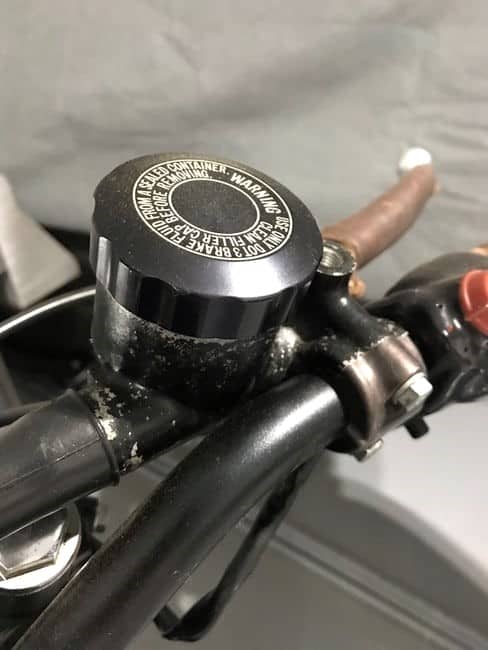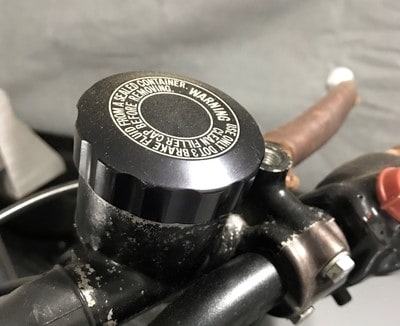
Making sure your motorcycle can safely come to a stop should be the first step of motorcycle maintenance. Before making sure the engine runs and the carbs are clean, you should always make sure that your brakes are working. Fundamental to proper braking is a working master cylinder. A brake master cylinder can be found on almost all motorcycles.
Sitting next to the front brake lever is a tiny brake fluid reservoir that allows for pressure to be transferred from the lever, and then sent to the front brakes to allow for smooth and easy braking. Just like any component on a motorcycle, master cylinders are prone to wear, and over time might need to be replaced.
What are signs of a bad motorcycle master cylinder? Signs that your motorcycle master cylinder has gone bad may include the cylinder leaking, the brakes feeling overly firm and difficult to engage, if the brake fluid appears contaminated, or if the brakes are too soft and spongy. If you are experiencing these symptoms, it may be time to fix or replace the master cylinder on your motorcycle.
More important than just knowing how to replace a broken master cylinder, is to know how to properly diagnose a faulty one.
Signs Your Master Cylinder Is Bad
Before we begin to diagnose the master cylinder in particular, we need to begin by doing a full visual inspection of the braking system on the bike. A major sign that a master cylinder is bad, is that the cylinder itself will be leaking.
The leak will generally start at the top of the system, the cylinder, and travel down the brake lines, or drip onto the fairings. Motorcycles that are equipped with rear disk brakes will also have a master cylinder above the rear brake pedal. If you are experiencing problems with the rear brake, make sure you also check for leaks around the rear cylinder.
Another sign that the master cylinder is bad, is that the pedal or lever feel will be too loose and squishy. A common problem is that there is a leak in the cylinder itself. This would mean that as pressure is placed on the system, air will enter the system, and weaken the pressure on the brake caliper. A soft or loose lever can directly affect the braking strength of the bike.
Another sign that the master cylinder is bad and in need of a rebuild or replacement is that the fluid in the container appears contaminated. A master cylinder is supposed to create a sealed environment for the brake fluid. The reason it needs to be tight is because brake fluid is hygroscopic. This means that when the fluid is sitting at room temperature and is exposed to the atmosphere, it will naturally absorb water.
This can cause problems for several reasons. The first is that as water is used to compress the caliper, it will heat up to boiling temperature and evaporate in the system. This will cause a gas to form. Gas in a brake line, whether its oxygen or otherwise, will not compress like a fluid will, and will cause the lever or the pedal to be squishy, and will hinder the bikes braking ability.
The other problem that water has is that it can cause particulates to form in the master cylinder.Contaminated fluid can look either discolored, or appear to be containing some type of debris or dirt. Clean brake fluid should be clear and look like cooking oil, and if the fluid is brown, closer to motor oil, you should change the fluid and inspect the master cylinder for leaks.
What To Do After The Master Cylinder Has Leaked
When you notice a leak in the master cylinder, it’s important to first find where the leak is coming from. It’s easy to tell where most leaks are coming from, because it will usually be at the highest spot that you can see the leak.
A good method to finding a leak is to clean everything off, use a brake cleaner or similar aerosol, and then wait to see if the leak comes back, and try to spot where the leak is coming from. It’s common to see a leak at points where a hose is attached to a fluid housing. Check around hose clamps or at points where there are seals. If you find any unwanted fluid, then you’ve found part of the leak.
After you find the source of the leak, try to determine what could have caused the leak. Could the hose that sits around the master cylinder mount need to be replaced? Is the hose clamp not tight? If the leak is coming from a brake line directly, maybe consider replacing the squish washer that generally sits around the master cylinder that prevents leaks.
The master cylinder also can use a plastic housing to hold the brake fluid. If your bike has been dropped, then it’s likely that this housing cracked or was damaged causing fluid to leak out of it and air to go into it. Brake fluid is a nasty substance to have anywhere near a painted surface. As soon as you notice that your brake fluid is leaking, you should try to clean it up off of the painted surfaces. If brake fluid is left on any of these, it could cause damage to the paint and cause it to flake.
How To Fix The Master Cylinder
The hardest part about a master cylinder repair is making sure that you properly diagnose the master cylinder. Sometimes we might assume a problem to be master cylinder related, when really, we just had old, contaminated fluid in the lines.
The actual repair on a master cylinder is really fairly easy and straight forward. The master cylinder for the front brakes is very easy to access and is right at the top of the handlebars. The rear one might be more difficult to reach, but is equally straight forward to replace.
After you determine that your master cylinder needs to be replaced, and you replace it, always make sure that you replace the fluid with brand new factory recommended brake fluid. Sometimes people keep used brake fluid containers around, but you shouldn’t ever put this into your bike.
It is already contaminated, and you should always buy new fluid. After fluid is put in, you should go through the process of bleeding the brakes. This means to get all the air out of the system that entered the system during the repair process. You shouldn’t forget to bleed the system, because if you do, you will find your brakes to be completely ineffective.
During the proper diagnostics you might determine that the master cylinder is properly functioning, but notice that some of the seals and washers have gone bad. Usually you can find master cylinder rebuild kits online. This can include all the washers and gaskets needed to seal your motorcycle’s master cylinder and make it like new again.
We have created an entire video series about how to restore a motorcycle from start to finish. Within this series includes an in-depth tutorial on how to replace a master cylinder and bleed the brakes which you may find useful in this situation. Also included are tutorials on other hard to tackle components such as carb rebuilds, electrical, and body work. Click here for more information if you’re interested in restoring or building your dream motorcycle!
Preventative Measures And Master Cylinder Maintenance
Just like any part of a bike, proper maintenance can help prevent components from going bad, and the master cylinder is no exception. A common problem that a master cylinder would face is dried and cracked o-rings, and worn out crush washers.
When you do a brake service on your bike, it’s not a bad idea to go through and replace some of these fittings. It’s inexpensive and simple, and in the end can really lengthen the life of the master cylinder.
You should also be on top of checking the condition of the brake fluid. If the brake fluid is contaminated, then it is probably time to change it before the particulates cause any other problems with the brakes. Also, you should always be conscious of what condition your brakes are in. Try to be in tune with the motorcycle so that when something comes up, you’ll be able to recognize it before it begins to have a more serious affect on the motorcycle’s ability to brake.
As always, you should be meticulous about taking care of your motorcycle and its safety systems. Specifically, you should take very good care of your brakes, and the systems related to it. Take good care of your bike, and your bike will take good care of you.

